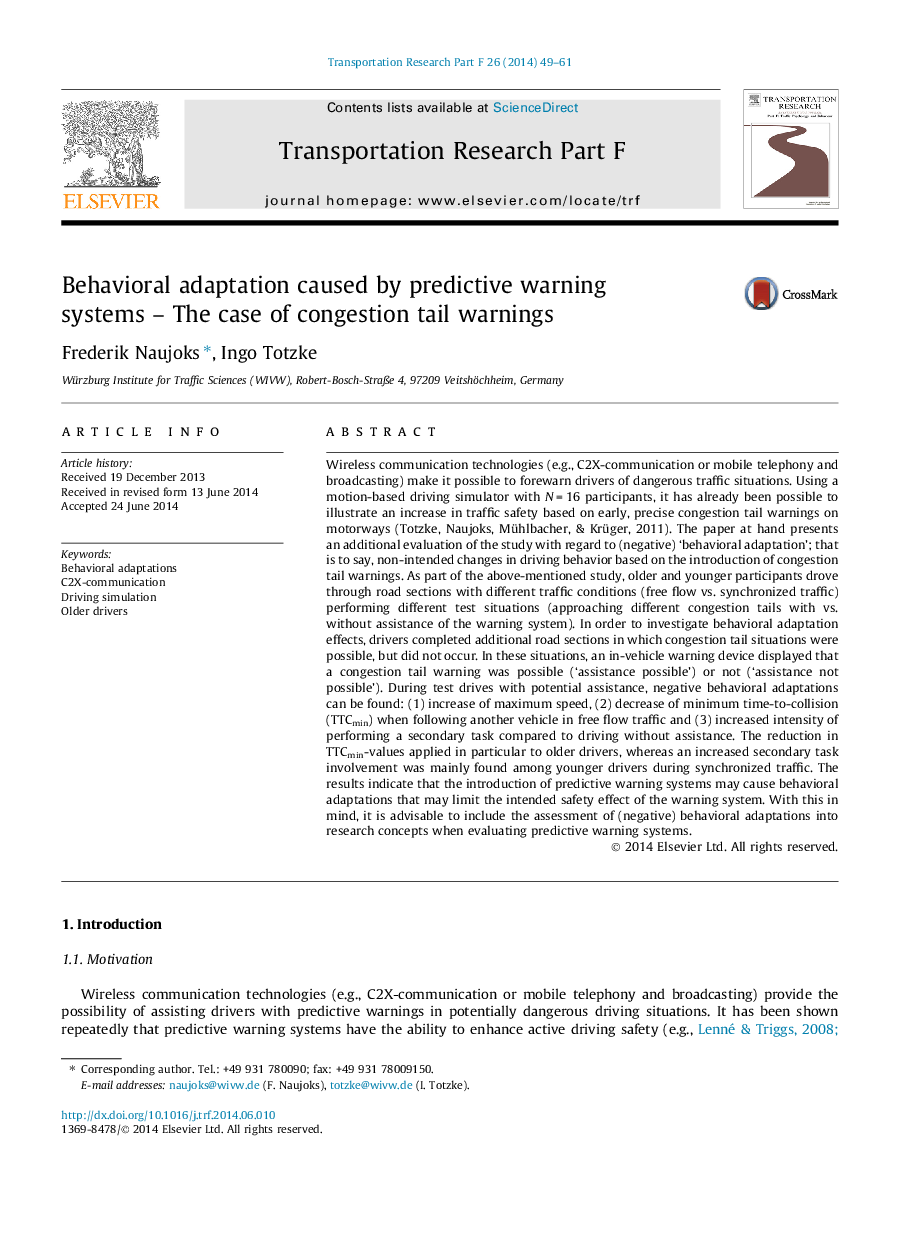| کد مقاله | کد نشریه | سال انتشار | مقاله انگلیسی | نسخه تمام متن |
|---|---|---|---|---|
| 10442953 | 915195 | 2014 | 13 صفحه PDF | دانلود رایگان |
عنوان انگلیسی مقاله ISI
Behavioral adaptation caused by predictive warning systems - The case of congestion tail warnings
ترجمه فارسی عنوان
سازگاری رفتاری ناشی از سیستم های هشدار دهنده پیش بینی - مورد هشدارهای احتمالی احتقان
دانلود مقاله + سفارش ترجمه
دانلود مقاله ISI انگلیسی
رایگان برای ایرانیان
موضوعات مرتبط
علوم انسانی و اجتماعی
روانشناسی
روان شناسی کاربردی
چکیده انگلیسی
Wireless communication technologies (e.g., C2X-communication or mobile telephony and broadcasting) make it possible to forewarn drivers of dangerous traffic situations. Using a motion-based driving simulator with NÂ =Â 16 participants, it has already been possible to illustrate an increase in traffic safety based on early, precise congestion tail warnings on motorways (Totzke, Naujoks, Mühlbacher, & Krüger, 2011). The paper at hand presents an additional evaluation of the study with regard to (negative) 'behavioral adaptation'; that is to say, non-intended changes in driving behavior based on the introduction of congestion tail warnings. As part of the above-mentioned study, older and younger participants drove through road sections with different traffic conditions (free flow vs. synchronized traffic) performing different test situations (approaching different congestion tails with vs. without assistance of the warning system). In order to investigate behavioral adaptation effects, drivers completed additional road sections in which congestion tail situations were possible, but did not occur. In these situations, an in-vehicle warning device displayed that a congestion tail warning was possible ('assistance possible') or not ('assistance not possible'). During test drives with potential assistance, negative behavioral adaptations can be found: (1) increase of maximum speed, (2) decrease of minimum time-to-collision (TTCmin) when following another vehicle in free flow traffic and (3) increased intensity of performing a secondary task compared to driving without assistance. The reduction in TTCmin-values applied in particular to older drivers, whereas an increased secondary task involvement was mainly found among younger drivers during synchronized traffic. The results indicate that the introduction of predictive warning systems may cause behavioral adaptations that may limit the intended safety effect of the warning system. With this in mind, it is advisable to include the assessment of (negative) behavioral adaptations into research concepts when evaluating predictive warning systems.
ناشر
Database: Elsevier - ScienceDirect (ساینس دایرکت)
Journal: Transportation Research Part F: Traffic Psychology and Behaviour - Volume 26, Part A, September 2014, Pages 49-61
Journal: Transportation Research Part F: Traffic Psychology and Behaviour - Volume 26, Part A, September 2014, Pages 49-61
نویسندگان
Frederik Naujoks, Ingo Totzke,
